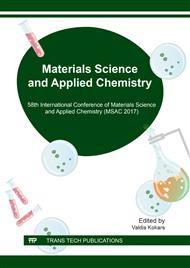[1]
L. Dabare, R. Svinka, Influence of thermal treatment and combustible additives on properties of Latvian clay ceramic pellets. Processing and Application of ceramics. 7, (4) (2013) 175-180.
DOI: 10.2298/pac1304175d
Google Scholar
[2]
T.O. Goodhead, K.K. Dagde, Adsorption of acetic acid, cadmium ion, lead ions and iodine using activated carbon from waste wood and rice husks. J. Appl. Sc. and Environmental Management, 15 (2), (2011) 407–410.
DOI: 10.4314/jasem.v15i2.68535
Google Scholar
[3]
R. Svinka, V. Svinka, I. Pudze, M. Damberga, Clay Ceramic Pellets for Water Treatment, RTU: Material Sc. and Appl. Chem. 32 (2015) 39-44.
DOI: 10.1515/msac-2015-0007
Google Scholar
[4]
R. Svinka, V. Svinka, O. Lescinskis, Possible modification of porous clay ceramic for environmental technologies, Proceed. 57th Int. Scientic Conf. RTU, Riga, (2016) 186-190.
DOI: 10.4028/www.scientific.net/ast.91.88
Google Scholar
[5]
L. Dabare, R. Svinka, V. Svinka, Sorption of inorganic substances on the porous Latvian clay ceramic, Latvian Journal of Chemistry, 4, (2012) 383-388.
DOI: 10.2478/v10161-012-0020-0
Google Scholar
[6]
R. Svinka, V. Svinka, L. Dabare, O. Lescinskis, Porous clay ceramic for environmental technologies, Advances in Science and Technology, 91, (2014) 88-93.
DOI: 10.4028/www.scientific.net/ast.91.88
Google Scholar
[7]
Q.U. Jiuhui. Research progress of novel adsorption processes in water purification: A review, J. Environ. Sci., 20 (2008) 1–13.
Google Scholar
[8]
V.K. Gupta, Suhas, Application of low-cost adsorbents for dye removal: A review, J. Environ. Manage, 90 (2009) 2313–2342.
DOI: 10.1016/j.jenvman.2008.11.017
Google Scholar
[9]
S. Kushwaha, H. Soni, V. Ageethe, P. Padmaja, An insight into the production, characterization and mechanisms of action of low-cost adsorbents for removal of organics from aqueous solution, Crit. Rev. Environ. Sci. Technol., 43 (2013) 443–549.
DOI: 10.1080/10643389.2011.604263
Google Scholar
[10]
A. Berzins, Z. Petrina, V. Nikolajeva, R. Svinka, V. Svinka, S. Strikauska, O. Muter Characteristics of a Ceramic Carrier after Wastewater Treatment Process in the Model Column Cascade with Ethanol Addition. The Open Biotechnology Journal, 9 (2015).
DOI: 10.2174/1874070701509010076
Google Scholar
[11]
O. Muter, K. Potapova, V. Nikolajeva, Z. Petrina, T. Griba, A. Patmalnieks, R. Svinka, V. Svinka, Comparative study on Bacteria Colonization onto ceramic beads originated from two Devonian clay deposits in Latvia, RTU: Material Sc. and Appl. Chem. 26 (2012).
DOI: 10.2174/1874070701509010076
Google Scholar
[12]
V. Svinka, L. Bidermanis, A. Cimmers, R. Svinka. Latvian patent LV 14291 B. Int. Cl. C04B38/00; C04B38/06; C04B33/13; C04B33/32 The method of obtaining expanded clay. Published 20. 05. (2011).
Google Scholar
[13]
V. Svinka, R. Svinka, L. Bidermanis, I. Timma, A. Cimmers, Clay raw materials for the fast firing technology of expanded clay pellets, RTU: Material Sc. and Appl. Chem 26 (2012) 49-54 (in Latvian).
Google Scholar
[14]
F. Rodriguez-Reinoso. Activated carbon: Structure, characterization, preparation and applications. Introduction to Carbon Technology, Ed. University of Alicante, 1997, 669.
Google Scholar
[15]
W. Heschel, E. Klose, On the suitability of agricultural by-products for the manufacture of granular activated carbon, Fuel, 74, (1995) 1786-1791.
DOI: 10.1016/0016-2361(95)80009-7
Google Scholar


